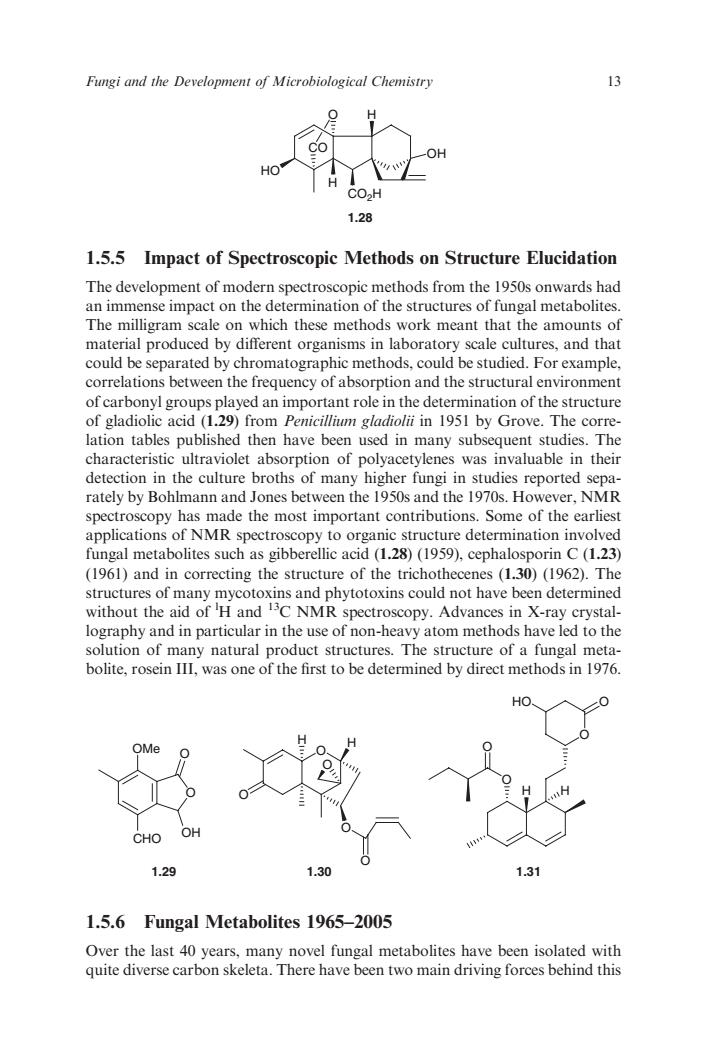正在加载图片...

Fungi and the Development of Microbiological Chemistry 13 OH Co,H 1.28 1.5.5 Impact of Spectroscopic Methods on Structure Elucidation The development of modern spectroscopic methods from the 1950s onwards had an immense impact on the determination of the structures of fungal metabolites. The milligram scale on which these methods work meant that the amounts of material produced by different organisms in laboratory scale cultures,and that could be separated by chromatographic methods,could be studied.For example. correlations between the frequency of absorption and the structural environ of carbonyl gro s played an i acid (1.20 by Grove lation tab s publishe used in many subsequent tudies characteristic ultraviolet absorption of polyacetylenes was invaluable in their detection in the culture broths of many higher fungi in studies reported sepa rately by Bohlmann and Jones between the 1950s and the 1970s.However,NMR spectroscopy has made the most important contributions.Some of the earliest applications of NMR spectroscopy to organic structure determination involved fungal metabolites such as gibberellic acid (1.28)(1959).cephalosporin C(1.23) (1961)and in correcting the structure of the trichothece e81.30m1g62)Th hytotoxins could not hav spectroscopy.Advan lography and in particular in the use of non-heavy atom methods have led to the solution of many natural product structures.The structure of a fungal meta bolite,rosein III,was one of the first to be determined by direct methods in 1976. 1.29 1.5.6 Fungal Metabolites 1965-2005 Over the last 40 years,many novel fungal metabolites have been isolated with quite diverse carbon skeleta.There have been two main driving forces behind this OH CO HO CO2H H O H 1.28 1.5.5 Impact of Spectroscopic Methods on Structure Elucidation The development of modern spectroscopic methods from the 1950s onwards had an immense impact on the determination of the structures of fungal metabolites. The milligram scale on which these methods work meant that the amounts of material produced by different organisms in laboratory scale cultures, and that could be separated by chromatographic methods, could be studied. For example, correlations between the frequency of absorption and the structural environment of carbonyl groups played an important role in the determination of the structure of gladiolic acid (1.29) from Penicillium gladiolii in 1951 by Grove. The correlation tables published then have been used in many subsequent studies. The characteristic ultraviolet absorption of polyacetylenes was invaluable in their detection in the culture broths of many higher fungi in studies reported separately by Bohlmann and Jones between the 1950s and the 1970s. However, NMR spectroscopy has made the most important contributions. Some of the earliest applications of NMR spectroscopy to organic structure determination involved fungal metabolites such as gibberellic acid (1.28) (1959), cephalosporin C (1.23) (1961) and in correcting the structure of the trichothecenes (1.30) (1962). The structures of many mycotoxins and phytotoxins could not have been determined without the aid of l H and 13C NMR spectroscopy. Advances in X-ray crystallography and in particular in the use of non-heavy atom methods have led to the solution of many natural product structures. The structure of a fungal metabolite, rosein III, was one of the first to be determined by direct methods in 1976. OMe CHO O O OH 1.29 O O H H O O O 1.30 O HO O O O H H 1.31 1.5.6 Fungal Metabolites 1965–2005 Over the last 40 years, many novel fungal metabolites have been isolated with quite diverse carbon skeleta. There have been two main driving forces behind this Fungi and the Development of Microbiological Chemistry 13